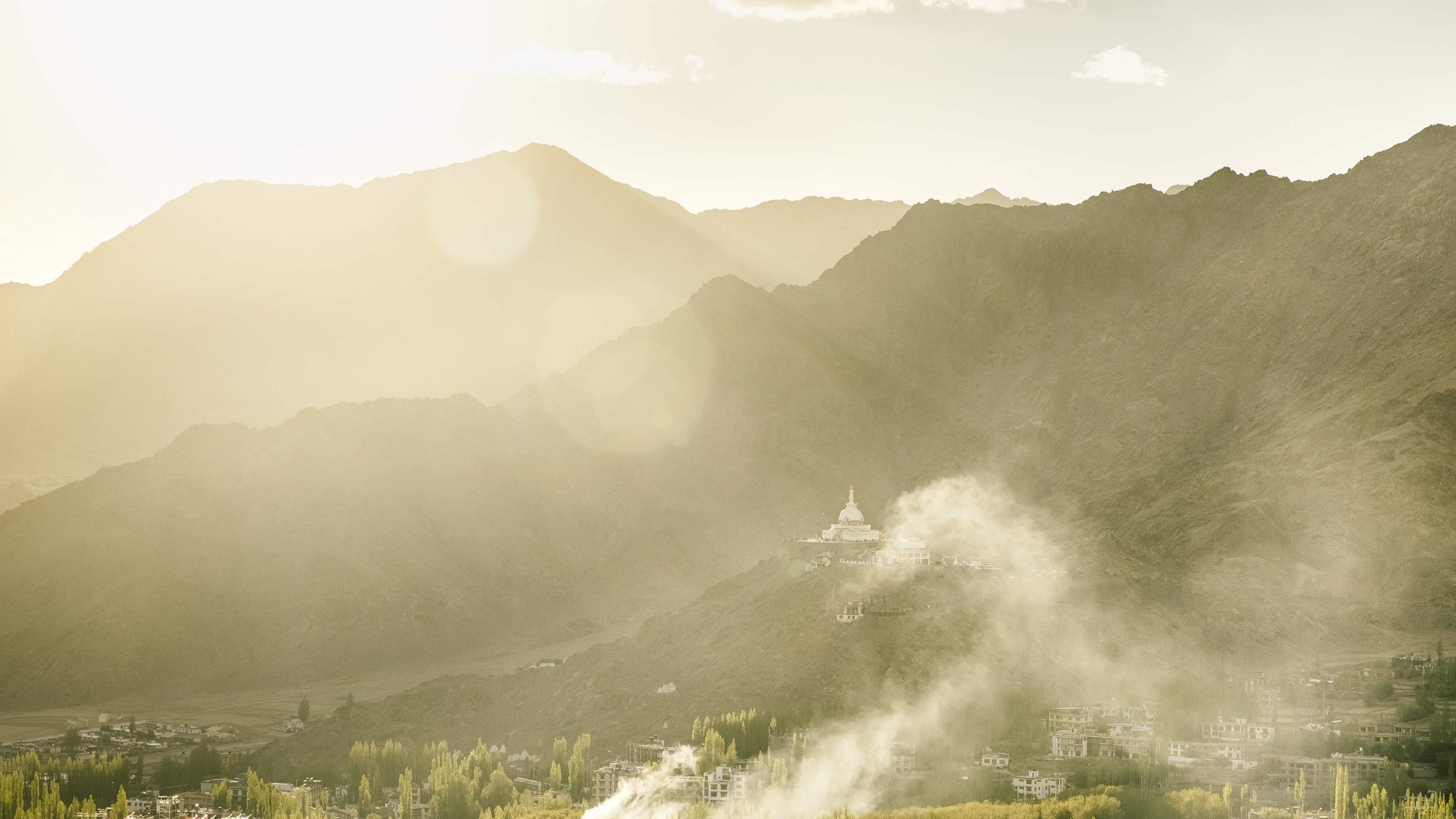Ladakhi Cuisine: A Culinary Heritage of Tradition and Innovation
In the Himalayan-edged region of Ladakh, the cuisine is infused with many cultures. By dipping into this diverse mix, a new generation of tastemakers is putting a fresh spin on tradition.
Everything revolves around the kitchen hearth, or “thap”, in Ladakh – even time. Many older Ladakhi homes have an opening through which the first rays of sunlight fall directly onto these earthen stoves, warming them before cooking begins, while turning them into sundials. As day becomes night, the shafts of light shift, capturing the dance of smoke in the air, while the thap casts shadows that tell the time.
In Nilza Wangmo’s kitchen, in the monastic mountain village of Alchi, it’s just past one o’clock and the light has moved off the center of the thap. From between her flour-coated palms, long, silken strands of noodles fall softly into a bowl. “When I cook, I feel as if my mother is with me,” shares the soft-spoken, bespectacled 43-year-old, as she oversees her all-women kitchen crew. It was her late mother who taught her to cook timsthuk, an earthy noodle soup brightened by Ladakhi peas, dried cheese, and wild chives. Now, it is one of the star dishes at Alchi Kitchen, a rustic, wood-engraved restaurant adorned with traditional copper pots and vibrant red tables.
Wangmo is part of a humble modern movement to reclaim and shine a light on Ladakhi food – a cuisine as rich and complex as this northern corner of India. Until recently, Ladakh’s fragrant pulao dishes, stinging nettle soups, and hearty stews rarely made it beyond the region’s complicated mountainous borders. However, a new group of food enthusiasts is spreading the word. Wangmo has hosted pop-ups in New Delhi and Mumbai to showcase her beloved regional food; local brands are making indigenous ingredients such as sea buckthorn and buckwheat accessible; while well-respected chefs have started paying homage to the area through dining experiences.
Ladakh’s proud yet patchwork culture includes the legacy of Buddhist pilgrims, Tibetan refugees, and various traders. While much of the region feels Tibetan, Muslims make up a sizeable part of the population in areas such as Hunder and Kargil. Today’s boundaries are often arbitrary lines from the past that have divided families and cultures, generating ongoing disputes.
Throughout an enlightening week in Ladakh, food emerges as a way to understand and navigate the complex cultural landscape; a tangible symbol of identity, peaceful defiance, and hope. In the regional capital of Leh, I meet many locals who are using Ladakhi dishes as a tool for a cultural reckoning. This includes individuals who started Namza Dining to celebrate local dishes, like Yarkandi pulao, a buttery rice dish made with slow-cooked mutton and spices brought over by ancient traders. Innovative dining spaces are celebrating humble local ingredients such as apricot and barley, showcasing the depth of Ladakhi cuisine.
There are particularly memorable meals beneath elaborately painted wooden carvings at the historic Stok Palace, where local chefs create dishes that reflect the area’s rich history. Here, traditional Ladakhi ingredients meet modern presentations, enhancing the dining experience.
The table is laden with local specialities: zathuk, a version of Tibetan thukpa soup made with umami stinging nettles; khambir, a smoky sourdough; and drapu, dumplings in a velvety apricot-kernel sauce. “Hunger is secular here,” shares a local chef who has spent years studying Ladakhi cooking techniques. “So much of our food history is passed down orally and has been lost over generations.”
Each ingredient tells a story about the harsh landscapes and colliding cultures. One can taste yak meat sun-dried by nomads or stewed apricots grown in harmony with the region’s climate. There’s a sense of this vibrant food culture being co-opted into something fresh and dynamic, as chefs adapt traditional recipes and techniques.
The mood at the dining table remains hopeful yet cautious. Since Ladakh’s status shifted to a Union Territory directly under India’s central government, it has opened opportunities alongside the potential threats of tourism. Efforts are being made to ensure that this unique culinary heritage is preserved and celebrated, rather than lost amidst rising tourist demands.
Hope spreads beyond Leh. Journeying into Turtuk, once part of Pakistan until 1971, the focus on local food experiences continues. Here, a farm-to-table meal showcases fresh ingredients that speak of the region’s rich agricultural history. Diners revel in dishes made from herbs and vegetables plucked straight from the garden, emphasizing the importance of sustainability and local sourcing.
Each culinary venture in Ladakh, whether at a local eatery or a home kitchen, offers a glimpse into the rich tapestry of this unique culture. As locals share their stories through food, they foster understanding and connection, preserving the essence of their heritage.
Local Cuisine Highlights
- Timsthuk: Earthy noodle soup featuring peas, dried cheese, and wild chives.
- Zathuk: A comforting Tibetan thukpa coral soup made with stinging nettles.
- Khambir: Smoky sourdough bread baked over an open fire.
- Drapu: Dumplings served in a rich apricot-kernel sauce.
- Yarkandi Pulao: A buttery rice dish enriched with slow-cooked mutton.
Conclusion
In this old land at the crossroads of a new era, the people of Ladakh remain hungry for connection, success, and above all, a narrative that encapsulates their rich and evolving culture. Their culinary heritage is not simply about food; it is a reflection of their identity, resilience, and shared history, with every meal embodying the spirit of the thap where it all begins.




